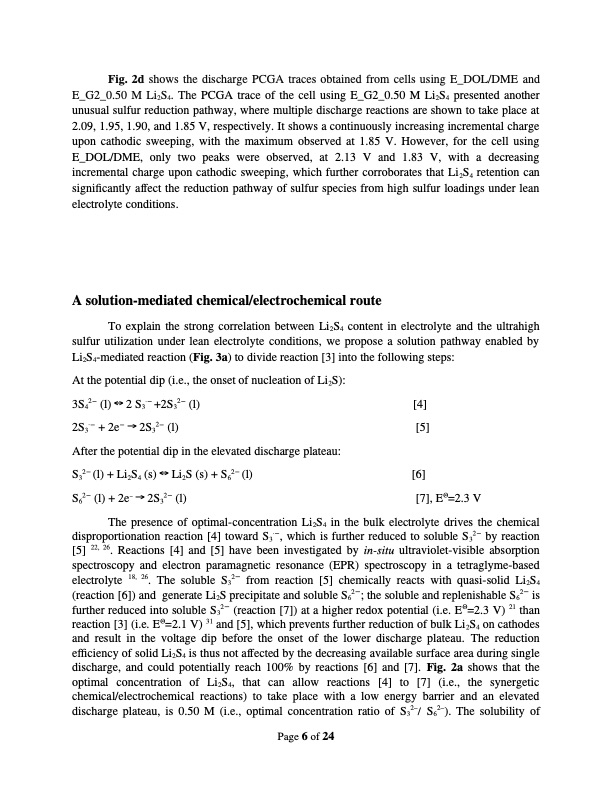
PDF Publication Title:
Text from PDF Page: 006
Fig. 2d shows the discharge PCGA traces obtained from cells using E_DOL/DME and E_G2_0.50 M Li2S4. The PCGA trace of the cell using E_G2_0.50 M Li2S4 presented another unusual sulfur reduction pathway, where multiple discharge reactions are shown to take place at 2.09, 1.95, 1.90, and 1.85 V, respectively. It shows a continuously increasing incremental charge upon cathodic sweeping, with the maximum observed at 1.85 V. However, for the cell using E_DOL/DME, only two peaks were observed, at 2.13 V and 1.83 V, with a decreasing incremental charge upon cathodic sweeping, which further corroborates that Li2S4 retention can significantly affect the reduction pathway of sulfur species from high sulfur loadings under lean electrolyte conditions. A solution-mediated chemical/electrochemical route To explain the strong correlation between Li2S4 content in electrolyte and the ultrahigh sulfur utilization under lean electrolyte conditions, we propose a solution pathway enabled by Li2S4-mediated reaction (Fig. 3a) to divide reaction [3] into the following steps: At the potential dip (i.e., the onset of nucleation of Li2S): 3S42− (l) ↔ 2 S3∙− +2S32− (l) 2S3∙− + 2e− → 2S32− (l) After the potential dip in the elevated discharge plateau: S32− (l) + Li2S4 (s) ↔ Li2S (s) + S62− (l) S62− (l) + 2e− → 2S32− (l) [4] [5] [6] [7], EΘ=2.3 V The presence of optimal-concentration Li2S4 in the bulk electrolyte drives the chemical disproportionation reaction [4] toward S3∙−, which is further reduced to soluble S32− by reaction [5] 22, 26. Reactions [4] and [5] have been investigated by in-situ ultraviolet-visible absorption spectroscopy and electron paramagnetic resonance (EPR) spectroscopy in a tetraglyme-based electrolyte 18, 26. The soluble S32− from reaction [5] chemically reacts with quasi-solid Li2S4 (reaction [6]) and generate Li2S precipitate and soluble S62−; the soluble and replenishable S62− is further reduced into soluble S32− (reaction [7]) at a higher redox potential (i.e. EΘ=2.3 V) 21 than reaction [3] (i.e. EΘ=2.1 V) 31 and [5], which prevents further reduction of bulk Li2S4 on cathodes and result in the voltage dip before the onset of the lower discharge plateau. The reduction efficiency of solid Li2S4 is thus not affected by the decreasing available surface area during single discharge, and could potentially reach 100% by reactions [6] and [7]. Fig. 2a shows that the optimal concentration of Li2S4, that can allow reactions [4] to [7] (i.e., the synergetic chemical/electrochemical reactions) to take place with a low energy barrier and an elevated discharge plateau, is 0.50 M (i.e., optimal concentration ratio of S32−/ S62−). The solubility of Page 6 of 24PDF Image | A lithium-sulfur battery with a solution-mediated pathway

PDF Search Title:
A lithium-sulfur battery with a solution-mediated pathwayOriginal File Name Searched:
qt9bt5f7wt_noSplash_4e336387563ecb2106bd171b37448483.pdfDIY PDF Search: Google It | Yahoo | Bing
Sulfur Deposition on Carbon Nanofibers using Supercritical CO2 Sulfur Deposition on Carbon Nanofibers using Supercritical CO2. Gamma sulfur also known as mother of pearl sulfur and nacreous sulfur... More Info
CO2 Organic Rankine Cycle Experimenter Platform The supercritical CO2 phase change system is both a heat pump and organic rankine cycle which can be used for those purposes and as a supercritical extractor for advanced subcritical and supercritical extraction technology. Uses include producing nanoparticles, precious metal CO2 extraction, lithium battery recycling, and other applications... More Info
| CONTACT TEL: 608-238-6001 Email: greg@infinityturbine.com | RSS | AMP |